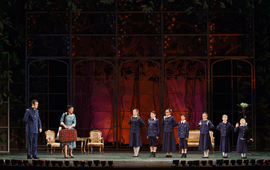> [Archived] Chronicles

'The Sound of Music' Reached Iasi
One could hardly fill the shoes of such stars! And yet, the theatre's actors, approaching a totally different kind of opera other than what they were accustomed to, moved from Carmen, Leporello or Gilda to completely different characters, as they have to shift quickly from the spoken text to easy singing in which expression is more important than acute and the vocal performance itself. Thus, Maria Maxim-Nicoara became a believable Mary, having a predestined name for the part. Octavian Dumitru portrayed a soldierlike then affectionate Captain von Trapp, Laura Scripcaru was a wise Mother Superior, George Cojocaru was a lovable Max, Diana Bucur was a spoilt Elsa and Mihaela Grajdeanu was a delicate Nun Sophia. The cast was various but an essential part was played by the children as their acting won us over. Their singing was accurate enough, as they were well-trained by Raluca Zaharia. They were very involved in the process and the incredible ease with which they acted did not fail them. And even though some soloists got some lines mixed up, involuntarily giving rise to humorous line such as 'I need seven children,' the little artists were faultless from this point of view too, much to the delight of the crowd which filled the hall to capacity. The stage directions of Mihaela Bogdan from Cluj are classical but with many faults. For example, the nuns wear high heels, Mary does not let go of her guitar although she does not use it at all, instead, she gives it to the Captain and to one of the girls to play it. Also, the father says that the little ones have never played with toys, but there is a chest in the house from which puppets appear out of nowhere, giving the impression that the children are familiarized with them and do not seem surprised by their existence. The story flows smoothly, however, without creating the expected atmosphere and the emotional load. The relationships between the characters are precisely outlined but rather unobtrusively, yet characterized by the main facts. The scenography thought by Valentin Codoiu, also from Cluj, is also pleasant but uneven because the forest and the castle's park are not quite different from each other, the computer drawings projected on the curtains switch from being childish to surrealist, and sometimes they even show some Oriental letters or numbers that are transformed in chandeliers. But the big picture is colorful and figurative, the costumes are well made so that many overlooked such details.
Set in record time but in perfect tune, the show will take on, I hope, a little bit of rhythm, grace and nerve at the future performances. The orchestra and the choir, except some dissonances of the sopranos, have evolved with style and aplomb. The conductor Mircea Holiartoc, who was invited from Galati, had a precise and accurate gesticulation, including in the 'a cappella' pages (the choir was trained by Manuel Giugula) or in the orchestral 'curtains.' The choreographic interventions, made by Edi Stancu and Andra Gheorghe, fit perfectly the overall picture. It seems that our soloists who sing in musicals have made it a rule of using lanyard microphones but I cannot understand their reasons, since performers usually sing extensive and challenging opera scores without any help of some sort and still sound very good, thank God, especially that the acoustics of the concert hall is ideal. Their towering voices can sing the text naturally and the microphone has its disadvantages too, as it can highlight technical or breathing problems. To make matters worse, some of the kids had microphones and were heard rather loudly, while others did not have microphones and you could have barely heard their voices, creating a mess which could have easily been avoided. If you need it anyway you can amplify the sound on the entire stage area, without everyone to wear 'transmitters;' this way, the bond between the soloists, the choir (who does not use microphones) and the orchestra would become more accurate, harmonious, organic and natural.
There are also aspects that did not overshadow the success secured by the new enactment, lingeringly applauded for the well-known music, the reliability and the involvement of everyone who was on that stage, in the orchestra pit or in the backstage, contributing to a captivating and enchanting show.
Although it seems hard to believe, in parallel, the ensemble and most of the soloists are rehearsing for a new enactment of Aida! I say it is a remarkable effort for which they deserve all the admiration of those who are aware of the fact that there is a premiere once every two weeks at the Iasi Opera House. And the manager Beatrice Rancea has already a busy schedule with various challenging projects, mind-blowing obviously!
Translated by Morosanu Petronela and Elena Daniela Radu
MTTLC, The University of Bucharest














